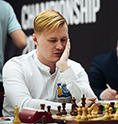16 September 2015
The Lead Change
IM Vladimir Barsky reviews the 10th round of the World U20 Championships.
The Polish GM Jan-Krzysztof Duda has expanded the lead with unexpectedly fast victory. He overplayed his opponent in the ending, which was supposed to be drawish.
Duda - Abasov
The Berlin Defense is played by professionals and those who want to join their ranks. White went for a rare line on the 12th move, and at least one of the opponents should have continued playing without home preparation.
1.e4 e5 2.Nf3 Nc6 3.Bb5 Nf6 4.0–0 Nxe4 5.d4 Nd6 6.Bxc6 dxc6 7.dxe5 Nf5 8.Qxd8+ Kxd8 9.h3 Ke8 10.Nc3 h5 11.Bf4 Be7 12.Rfe1 Be6 13.Ne4

13…h4
I found only one similar game in the Chessbase: 13...Rd8 14.c3 c5 15.Nfg5 Rh6 16.b3 Bd5 17.Rad1 Rg6 18.Kf1 Rd7 19.c4 Bxg5 20.Nxg5 Bxg2+ 21.Kxg2 Rxd1 22.Rxd1 f6 23.exf6 gxf6 24.Rd5 fxg5 25.Rxf5 gxf4+ 26.Kf3, draw, L. Milov - Zwahr, Deizisau 2015.
14.c3 14…Rh5 15.Nfg5 Rd8 16.g4 hxg3 17.fxg3 Rh6
The computer offers to solve problems by tactical means: 17...Bxg5 18.Bxg5 (harmless is 18.Nxg5 Ne7) 18...Rd3! 19.g4 Rhxh3 20.gxf5 Bxf5 21.Nf2 (White has nothing better) 21…Rdg3+ 22.Kf1 Rxg5 23.Nxh3 Bxh3+, and two pawns represent comfortable compensation for an exchange. However, Abasov simply removes the rook from the fork.
18.Nxe6 Rxe6 19.Rad1 Rd5
Using a tactical idea, Black could move the knight on d5: 19...Rxd1 20.Rxd1 Ne3!, and if 21.Bxe3 (21.Rd4 Nd5), then after 21...Rxe5 Black wins back a piece and fully equalizes the position. Now White gains a small advantage.
20.Kf2 Kd7 21.c4 Rxd1 22.Rxd1+ Kc8 23.g4 Bh4+ 24.Kf3

24…Ne7?
A bad blunder, after which Black gets a depressed position right away. The knight has the only opportunity to step back – 24...Nh6. White is better, but there is no clear way to strengthen the position, for example, 25.b4 (25.Bxh6 deserves attention, 25...gxh6 26.Kf4, and after 25.g5 Nf5 26.Kg4 g6 Black is fine, as the bishop on h4 can not be won) 25...b6 26.a4 Re7.
25.Bg5!
After this move Black's position is desperate.
25...Bxg5 26.Nxg5 Rg6 (26...Rxe5 27.Nxf7 – the rook is en prise and a checkmate on d8 threatens) 27.Nxf7 b5 28.Rd8+ Kb7 29.Re8 Nc8 30.c5 etc. Black resigns.
The Berlin Variation is quite cunning ! One mistake, and instead of a long defense in a slightly worse ending Black has to lay down the arms immediately.
Ulvi Bajarani came close to the victory, but this time fortune favored the Russian grandmaster.
Bajarani - Antipov
1.d4 Nf6 2.c4 e6 3.Nc3 Bb4 4.f3 c5 5.d5 0–0 6.e4 b5 7.e5 Ne8 8.f4 exd5 9.cxd5 d6 10.Nf3 Nc7 11.Bd3 c4 12.Bc2 dxe5 13.d6 Bxd6 14.fxe5 Bb4 15.Qxd8 Rxd8 16.Be4 Nd5 17.Bg5
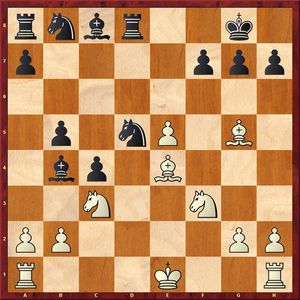
Black was very brave and provocative in the opening, and now he should be accurate to maintain an equal position: 17...Bxc3+ 18.bxc3 Rd7 19.0–0–0 Bb7 20.Bf5 g6 21.Bxd7 Nxd7 with sufficient compensation for an exchange.
17…f5?! 18.exf6 Nxc3
Black also got serious troubles after 18...Bxc3+ 19.bxc3 Re8 20.0–0–0 Rxe4 21.Rxd5 Nc6 22.Rf1.
19.bxc3 Re8 20.f7+!?
It's hard to refrain from such a beautiful combination, but the direct 20.0–0–0 Rxe4 21.Rd8+ Kf7 22.fxg7 Kxg7 23.Rxc8 Ba3+ 24.Kb1 is much simpler, as it's not clear how Black can unpin. Still, in this position White dominates too.
20...Kxf7 21.0–0 Rxe4 22.Nd2+ Kg6 23.Nxe4 Bb7 24.cxb4 Bxe4 25.Bd2 Nd7 26.Bc3
White could crush the opponent's pawn structure just to be on the safe side: 26.a4 Bd3 27.Rfe1 bxa4 28.Rxa4, but he decides to bother the opponent's king.
26...Nf6 27.Rae1 Re8 28.Re3 Nd5 29.Rg3+ Kh5 30.Bd2 h6 31.Rxg7 c3

32.Bc1?
White gets lost. He could win by 32.Bxc3! Nxc3 33.Rf6 (threatening with 34.g4+ Kh4 35.Rxh6#) 33…Rh8 34.Re6: White wants either to checkmate – 35.Re5+ Kh4 36.g3+ Kh3 37.Rh5#, or to attack the knight by Rc7, winning a piece. There was also a more practical way: 32.Be1 (threatening a checkmate in one) 32…Ne3 33.g4+ Nxg4 34.Bxc3, crushing the only Black's trump card.
32...Bd3 33.Rd1
Some winning chances remained after 33.Rf3 Re1+ 34.Kf2 Re2+ 35.Kg3 Be4 36.Rf2 Rxf2 (36...Re1 37.Kh3) 37.Kxf2 Nxb4 38.Ke3.
33...Nxb4 34.Ba3 c2 35.Ra1 Nxa2 36.Rxa2 Re1+ 37.Kf2 Re2+ 38.Kf3 c1Q 39.Bxc1 Rxa2 Draw.
In the women's event the all-time leader Zhansaya Abdumalik from Kazakhstan suffered her first defeat.
Bivol - Abdumalik

The Russian player gained a big advantage in the opening: the bishop on g2 is very strong, Black can hardly finish her pieces development. It's time to open the files.
20.c5! Nxc5 21.Nxc5 dxc5 22.Bxc5 Re8 23.Nc4 e4 24.Bb6
The move suggests itself, but more accurate is 24.Bd6! Bd8 25.Ba3! Bc7 26.Rac1.
24...Bxb6 25.Nxb6 Rb8 26.Rac1 Be6
Black could minimize the opponent's advantage by stopping the dangerous fianchettoed bishop: 26...f5! 27.Nd5 Ne5.
27.Bxe4 Bxh3 28.f3 Be6 29.Nd7 Rbd8 30.Nc5 Rxd1+ 31.Rxd1 Bxa2 32.Bxb7 a5
After 32...Bc4 33.Bxa6 (but not 33.e4? Be2) 33...Bxa6 34.Nxa6 Rxe2 35.Rd8+ Nf8 36.Nc5 Re7 (losing is 36...Rxb2 37.Nd7) 37.b4 White has good chances to win.
33.b3?!
Too neat; it was necessary to pay attention to the a5-pawn: 33.Ra1 Bc4 34.e4 Ne5 35.Kf2, and Black loses a pawn.
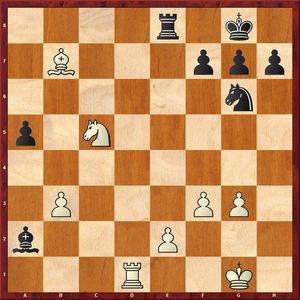
33...Nf8?
It is clear that the e2-pawn cannot be taken – 33...Rxe2? 34.Rd8+ Nf8 35.Nd7, but after 33...Rb8! (threatening Bxb3) 34.Bd5 (or 34.Rd7 Nf8) 34...Rb5 35.Ne4 Bxb3 36.Bxb3 Rxb3 37.Rd8+ Nf8 38.Nc5 Rb1+ 39.Kg2 g5 40.Nd7 Kg7 41.Nxf8 a4 42.Ra8 Rd1! Black escaped – White's knight is locked on f8.
34.Rd2! Bb1 35.Bd5 Bf5 36.Ra2 h5 37.e4 Be6 38.Rxa5
Perhaps more technically accurate is 38.Nxe6 fxe6 39.Bc4 Ra8 40.Ra4 Kf7 41.b4 Nd7 42.Be2! (but not the immediate 42.bxa5? Nb6). However, here White also has a good position.
38...Bxd5 39.exd5 Rd8 40.Ne4 Rb8 41.Nc5 Rd8 42.Nb7 Rd7 43.Rb5 Nh7 44.Kf2 g5 45.d6 Kf8 46.Rb6 Nf6 47.Nc5 Rd8 48.Rc6 Ke8 49.b4 Rb8 50.b5 g4 51.b6 Kd8

52.b7 Nd7 53.Nxd7 Kxd7 54.Rb6 Ke6 55.fxg4 hxg4 56.Ke3 f6 57.Kd4 f5 58.Kc5 Kd7 59.Rb4 Black resigns.
The Ukrainian Nataliya Buksa took advantage of the leader's failure, organizing a full-scale attack, winning and coming atop the standings. The main battle started after the time control.
Buksa - Ibrahimova
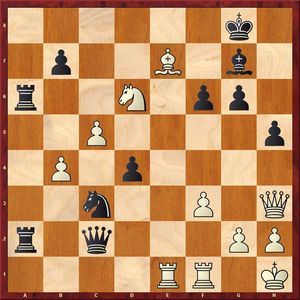
Both sides are attacking, but White advances in the center, while Black's pieces burst into the enemy camp through the queenside. So far White's strongest piece is busy with defense, but the queen on h3 can entrust defensive functions to the rook and join an attack pretty much anytime. Black is on move, and it is very important to block the path for the white queen: 45...f5! 46.Qg3 Kh7 47.Nf7 f4 48.Qh3 Qf5! In this case the chances of Azerbaijani player would be higher, because almost all endgames are better for Black.
45…Nd5? 46.Rg1?
Correct is 46.Qe6+ Kh8 47.Rg1 Nf4 48.Qc8+ Kh7, getting the same position, as occurred in the game later.
46...Nf4?
Here 46...f5! is necessary too.
47.Qc8+ Kh7
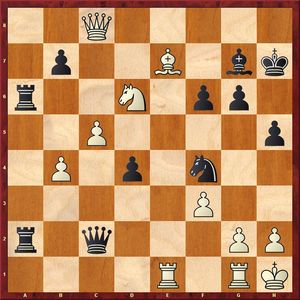
48.Qd7
White could secure a spectacular victory after 48.Bxf6! The variations here are long and hard to calculate, but beautiful: 48…Bxf6 49.Qc7+ Kh6 (49...Bg7 50.Ne8) 50.Nf7+ Kh7 51.Ng5+ Kh6 52.h4 Bxg5 (after 52...Bg7 53.Re8 Ra8 54.Re7 Rg8 55.Rxg7 Rxg7 56.Qb8 Black's king is trapped) 53.hxg5+ Kxg5 54.Qe7+ Kh6 55.Qf8+ Kg5 56.Re5+ Qf5 57.g3!, and the rook on g1 suddenly gets involved in an attack!
48...Nd3 49.Ne4
Defending from the smothered checkmate and at the same time moving the knight on a strong outpost.
49…Ne5
More stubborn is 49...Qc4! (involving the queen into defense) 50.Rd1 (but not 50.Nxf6?+ Rxf6) 50...Ne5.
50.Nxf6+ Rxf6 51.Rxe5 Rxf3
After 51...Rf7 52.Qd5 Kg8 53.Re6 Black is bad.
52.Bf6 Rxf6 53.Re7

53…Rf2
53...Qf2 allowed to continue the fight, threatening ...Qxg1+! Of course, after 54.Rxg7+ Kh6 55.Rh7+ Kg5 56.Qd5+ Rf5 57.Qd8+ Rf6 Black is close to a defeat, but the position is challenging and under the permanent time pressure anything can happen.
54.Rxg7+ Kh6 55.h4! The most accurate. Black resigns.






















